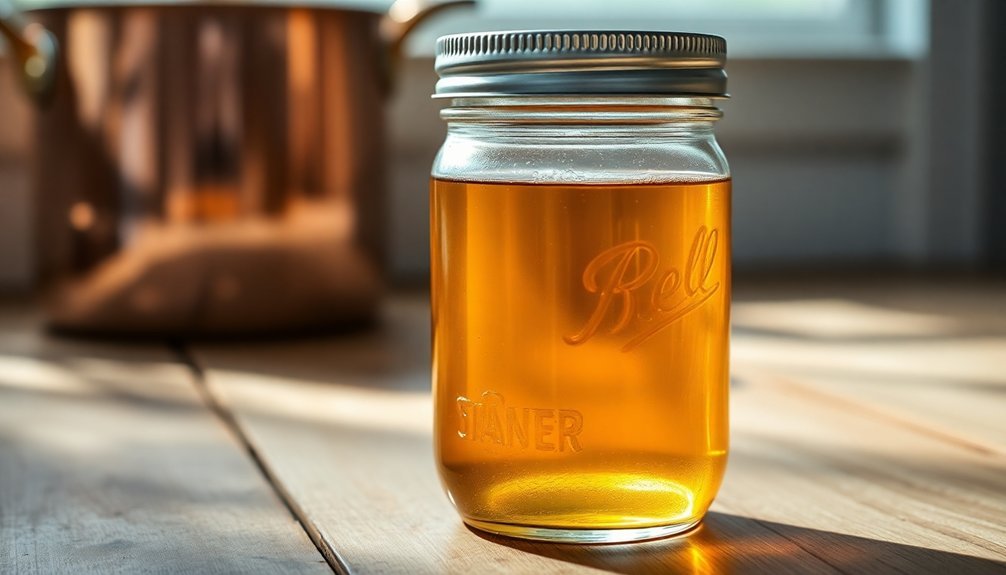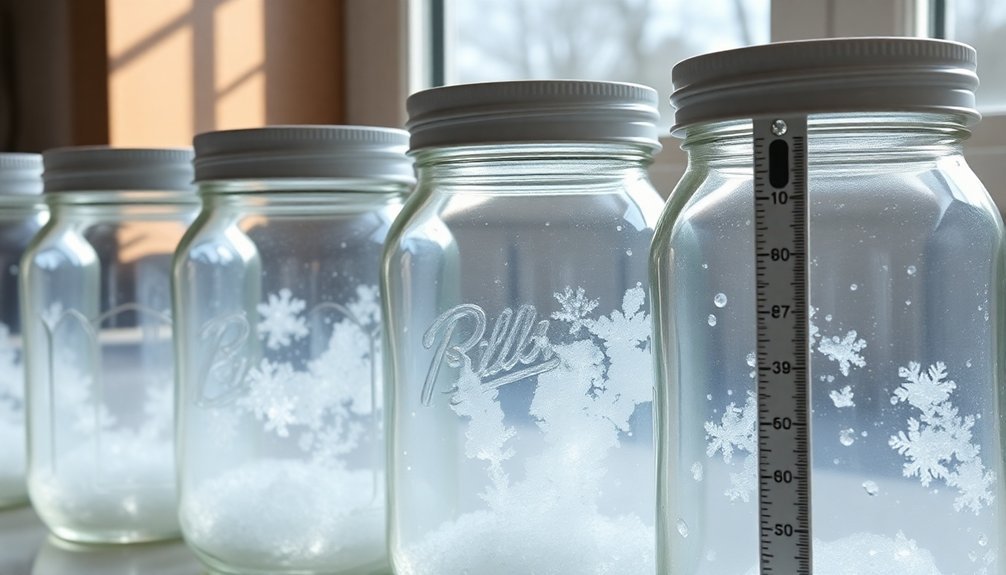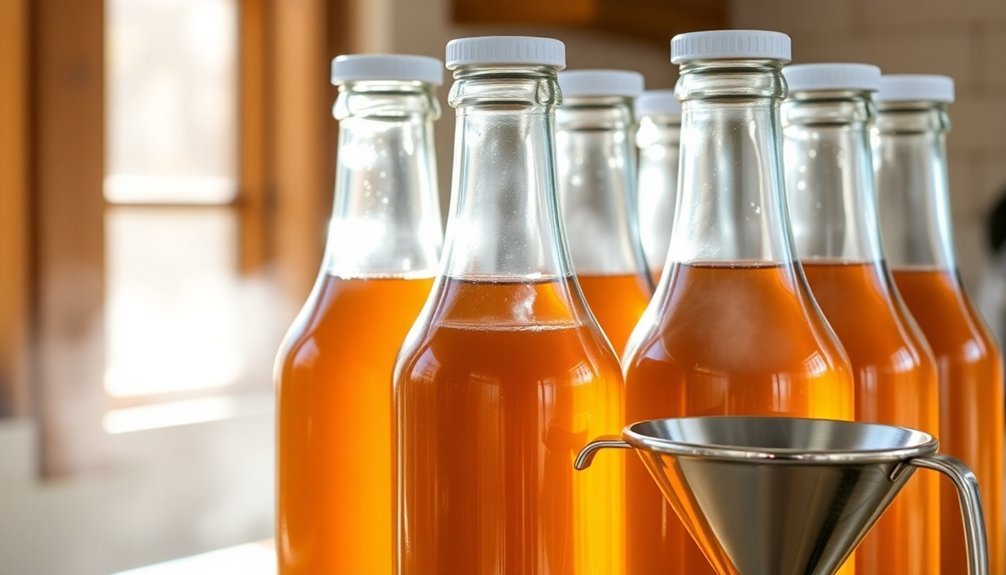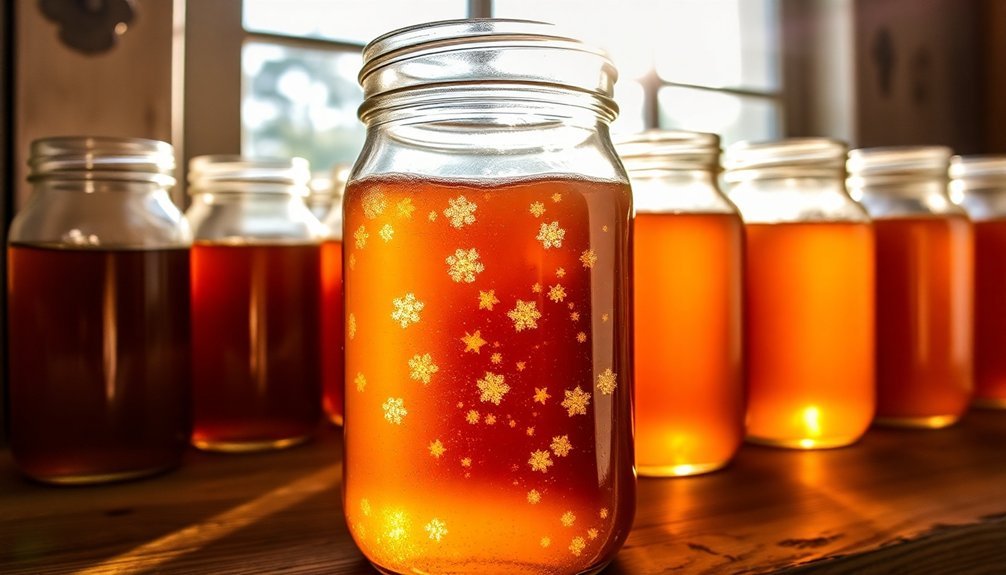Store your simple sugar syrup in sterilized glass containers like mason jars or swing-top bottles to maintain flavor integrity. You'll want to use a 2:1 sugar-to-water ratio for rich syrup, which lasts longer than basic 1:1 syrup. Always refrigerate after preparation, and for extended storage, you can freeze the syrup in tempered glass or plastic containers. Don't use metal containers as they can react with the syrup. Natural preservatives like citrus oils or herb infusions can extend shelf life while adding flavor. Label and date your containers to track freshness. There's much more to preserving your syrup's quality than meets the eye.
Best Storage Container Options

When it comes to storing simple syrup, glass containers stand out as the best choice for long-term storage. Glass jars and bottles, especially Boston round style apothecary bottles, won't retain food odors or contaminate your syrup's flavor. For smaller batches, 8oz glass containers work perfectly, while larger swing-top bottles and mason jars are ideal when you're making bigger quantities. Explore many glass options available through online retailers and specialty shops.
You'll want to avoid metal containers completely, as they can react with your syrup and affect its quality. While plastic containers can work for freezing, they're not recommended for refrigerator storage because they tend to retain odors.
If you're planning to freeze your syrup, make sure to use tempered glass or plastic containers specifically designed for freezing. For convenient pouring, especially with larger batches, look for containers with easy-pour designs. Glass canning jars offer excellent versatility and seal tightly to prevent contamination.
If you'd like to portion your syrup for future use, you can freeze it in ice cube trays and then transfer the frozen cubes to a clean container. Remember, whatever container you choose, it should be thoroughly cleaned and sterilized before use to guarantee your syrup stays fresh.
Temperature Control Methods
Proper temperature control stands at the core of successful syrup storage and preparation. When you're making simple syrup, you'll need to use boiling water to effectively dissolve the sugar and kill any unwanted fungi or bacteria. Give the syrup a brief boil to sterilize it, but don't overdo it, as excessive boiling can alter the sweetness ratio and compromise flavor.
You'll also want to sterilize your storage container with boiling water to prevent contamination. Commercial liquid syrups typically maintain quality for one year when unopened.
Once you've prepared your syrup, refrigeration becomes essential. You must store it in the fridge because the water content can breed microorganisms at room temperature. While rich simple syrup has a longer shelf life due to higher sugar content, it still needs refrigeration.
If you're considering long-term storage, freezing is an option, though the syrup won't freeze solid due to its sugar content.
Be careful to avoid exposing your syrup to high temperatures during storage, as this can lead to crystallization and unwanted color changes. When using the freezer, make sure you're using freezer-safe containers, and always monitor your syrup for any signs of spoilage, such as cloudiness or off-putting odors.
Long-Term Freezing Techniques

Long-term freezing offers the most reliable method to preserve your sugar syrup for extended periods. When preparing for freezer storage, you'll need to choose the right container and prepare your syrup properly.
Select either clean plastic containers or tempered glass vessels, avoiding regular glass that might crack in freezing temperatures. Plastic containers are your best bet due to their flexibility and durability.
For ideal freezing results, prepare your syrup using a 2:1 sugar-to-water ratio (rich simple syrup). Use distilled water and verify all your equipment is thoroughly clean or sterilized. The freeze-thaw method can significantly reduce your final volume, making storage more efficient.
Dissolve the sugar in boiling water to eliminate potential bacteria. Once prepared, transfer your syrup to your chosen container, leaving some headspace for expansion.
Don't worry if your syrup doesn't freeze solid – that's normal due to its high sugar content. You'll need to label your container with the date and seal it tightly to prevent contamination.
When you're ready to use it, let it thaw in the refrigerator or at room temperature. Remember to check for any signs of spoilage, such as cloudiness or off-putting odors, before using your stored syrup.
Natural Preservation Additives
You'll find remarkable preservation power in natural additives like citrus peel essential oils, which offer both antimicrobial properties and enhanced flavor to your syrups.
A blend of honey and lemongrass creates a robust preservation system while adding depth to your mixtures, as honey's natural antibacterial qualities work alongside lemongrass's protective compounds.
Fresh herb infusions, such as rosemary or thyme, can extend your syrup's shelf life through their natural antimicrobial properties while introducing complex botanical notes.
Citrus Peel Essential Oils
Among nature's most effective preservatives, citrus peel essential oils offer a powerful solution for extending the shelf life of sugar syrups. You'll find these oils extracted from discarded peels of oranges, lemons, and bergamot, making them an environmentally conscious choice while harnessing their natural preservative powers.
When you add citrus essential oils to your sugar syrup, you're introducing powerful antimicrobial compounds that fight against harmful bacteria like E. coli and Salmonella. You only need a small amount – as little as 0.06 mg/g can effectively preserve your syrup.
These oils don't just fight bacteria; they're also potent antioxidants that prevent your syrup from deteriorating over time.
You can incorporate these oils through various methods, including microencapsulation or by creating nanoemulsions for better distribution throughout your syrup. They'll work as a natural alternative to chemical preservatives, helping you avoid synthetic additives.
While using citrus peel oils, remember to take into account potential allergies and stick to recommended dosage limits. Their dual antimicrobial and antioxidant properties make them an excellent choice for keeping your sugar syrup fresh and safe for longer periods.
Honey and Lemongrass Blend
Natural preservation takes on a new dimension with the honey and lemongrass blend in sugar syrup storage.
You'll get the best results by using a 1:1 ratio of honey to water for a mild flavor, or 2:1 if you're seeking a stronger honey presence. When you're adding lemongrass, infuse it gently without heating the sugar to maintain its bright, citrusy notes.
Store your honey-lemongrass syrup blend in glass or stainless steel containers with tight-fitting lids, avoiding plastic which can leach unwanted components.
You'll want to keep the syrup at room temperature between 10°C and 20°C, away from direct sunlight and heat sources. Don't refrigerate honey-based syrups, as this can trigger crystallization.
While traditional simple syrups can last up to 4 weeks in the fridge, your lemongrass blend will stay fresh for about a week.
You can extend its shelf life by adding a pinch of salt to enhance flavors. If you're planning for long-term storage, pour the syrup into ice cube trays and transfer to freezer-safe containers.
Watch for any cloudiness or bacterial growth – if you spot either, it's time to discard the syrup.
Fresh Herb Infusions
Moving beyond honey-based preservatives, fresh herb infusions offer an exciting array of flavors and preservation benefits for your sugar syrups.
You'll want to start by harvesting your herbs in the morning when their essential oils are most concentrated, ensuring you're using organic varieties to avoid any pesticide contamination.
To create your infusion, bring water to a simmer and dissolve your chosen sugar using a 1:1 ratio. You can experiment with different sugars like white, raw, or brown to achieve your desired flavor profile.
Once the sugar's fully dissolved, add your fresh herbs and let them steep for 15-20 minutes, though you can extend this time for stronger flavors.
After infusion, strain out the herb particles and transfer your syrup to glass containers – they're ideal since they won't stain like plastic might.
You'll get the best results storing your creation in the refrigerator, where it'll keep for up to a month. If you've made a larger batch, freeze portions in airtight containers for up to three months.
Don't forget to label and date your containers so you can track freshness and identify different herb varieties easily.
Sterile Bottling Process

You'll need to thoroughly sanitize your bottles with hot water or a sterilizing solution before starting the bottling process.
The hot fill method requires you to pour your sterilized syrup into clean bottles while it's still hot (around 180°F/82°C), which helps sterilize the inside of the containers.
For extra protection, you can use steam sterilization by placing your clean bottles in a large pot with steam for 10 minutes before filling them with syrup.
Sanitize Bottles Before Use
Keeping your bottles sterile stands as the most critical step in preserving sugar syrup safely.
You'll need to thoroughly clean and sanitize your containers before filling them with syrup to prevent contamination and guarantee long-term preservation. Choose food-grade glass bottles rather than plastic ones, as they won't retain odors or affect the syrup's flavor.
- Boil your bottles in water for 10 minutes, using a grid inlay or cloth at the bottom of the pot to prevent direct heat damage.
- Place clean bottles in an oven at 180-240°F for 20 minutes if you're using flip-top bottles with rubber stoppers.
- Use a steam cooker or canning machine as an alternative sterilization method.
- Fill bottles immediately with hot syrup using a clean funnel, then seal them right away.
Don't forget to inspect your bottles for any residue or damage before starting the sterilization process.
Once you've filled and sealed the bottles, store them in a cool, dark place or refrigerate them immediately.
You'll want to check your stored syrup regularly for any signs of spoilage, such as cloudiness or unusual taste.
Hot Fill Method
The hot fill method stands as a critical sterilization process for bottling sugar syrup safely. You'll need to heat your syrup to 194-203°F and maintain this temperature for at least 15 seconds to eliminate harmful microorganisms.
Don't let the temperature drop before the required time, as this can compromise sterilization.
Pour your hot syrup directly into sterile bottles using a funnel to avoid contaminating the closure area. You'll want to seal the bottles immediately to create a vacuum effect.
After sealing, flip the bottles on their side or upside down to sterilize the caps. Make sure you're using heat-resistant containers, like glass or appropriate polymers, that can handle these high temperatures.
Once filled and sealed, cool your bottles quickly and store them in a refrigerator. When you follow this method correctly, you can extend your syrup's shelf life up to a year or longer.
Keep checking your stored syrup for any signs of spoilage or contamination. The combination of proper hot filling and refrigeration will keep your syrup safe and fresh for extended periods, potentially lasting a month or more when refrigerated.
Steam Sterilization Steps
Mastering steam sterilization requires precise equipment setup and temperature control. You'll need a steam cooker or large pot with an inlay grid to prevent bottle damage, along with heat-resistant glass bottles and rubber stoppers.
The key is maintaining dry saturated steam with at least 97% dryness fraction for effective sterilization.
To achieve proper sterilization, you'll need to expose your bottles to specific temperature and time combinations. Use either 121°C (250°F) for 30 minutes or 132°C (270°F) for 4 minutes while monitoring pressure levels carefully.
- Set up your sterilization equipment in a clean environment and check that all components are contaminant-free.
- Fill bottles with hot syrup immediately after cooking, using a funnel to avoid touching the closure area.
- Leave appropriate headspace for expansion and seal bottles instantly to create a vacuum.
- Place sealed bottles on their sides with necks down to sterilize the air pocket and cap.
After sterilization, check for proper sealing and any potential leaks.
You'll want to store your bottles in a cool, dry place and monitor them regularly for signs of spoilage. This careful attention to detail guarantees your syrup stays preserved and safe for consumption.
Shelf Life Factors
Understanding the factors that influence sugar syrup shelf life can help you maximize its storage duration and maintain quality. The sugar-to-water ratio plays a vital role, with rich simple syrup (2:1) lasting up to a month or longer compared to basic syrup's (1:1) two-week shelf life when refrigerated.
Your choice of storage method directly impacts longevity. You'll get the best results by keeping your syrup in the refrigerator, while room temperature storage considerably reduces its lifespan. If you can't refrigerate, store it in a cool, dark place away from heat sources to prevent crystallization and flavor degradation.
The type of syrup also affects its durability. Fruit-flavored varieties typically last only two weeks, while plain simple syrup keeps longer. You can extend shelf life by adding preservatives like sodium benzoate combined with citric acid, pushing duration to several months.
For maximum preservation, consider freezing your syrup – it'll last up to a year when properly stored in appropriate containers.
Container selection matters too. You'll want to use glass containers with airtight lids to prevent contamination and preserve flavor. Remember to sterilize all containers before use to minimize bacterial growth and extend shelf life.
Detecting Quality Changes

Detecting spoilage in sugar syrup relies on four key indicators you'll want to monitor regularly: visual appearance, texture, smell, and taste. Fresh syrup should maintain a clear or slightly amber color with a smooth, flowing consistency. If you notice cloudiness, unusual colors, or floating particles, it's time to discard the syrup.
- Watch for visual changes including fuzzy patches, mold growth on surfaces, darkening of the liquid, or sediment accumulation at the bottom of your container.
- Check the texture by pouring a small amount – it shouldn't be overly thick, separated, or crystallized. If you notice any lumpy consistency even after stirring, your syrup's likely spoiled.
- Trust your nose – fresh syrup has a neutral, sweet smell. Any sour, fermented, or off-putting odors indicate deterioration.
- Taste test only if other indicators appear normal. A sour, bitter, or rancid flavor means it's spoiled.
Remember that proper storage conditions greatly impact syrup quality. High temperatures and humidity accelerate bacterial growth, while maintaining appropriate glucose concentration helps inhibit microbial proliferation.
When in doubt about your syrup's safety, it's better to discard it.
Emergency Storage Solutions
A well-stocked pantry needs reliable emergency storage solutions for sugar syrup when regular preservation methods aren't available.
When faced with unexpected storage challenges, you'll want to focus on container selection and location alternatives to maintain your syrup's quality.
For emergency container options, reach for glass jars or tempered bottles rather than plastic or metal. Glass won't retain odors or affect flavor, and if you're making larger batches, swing-top bottles or mason jars will serve you best.
You can even use tempered glass for freezer storage, as syrup won't freeze solid due to its sugar content.
To maximize shelf life in emergency situations, prepare a rich syrup using a 2:1 sugar-to-water ratio. Make sure you're dissolving the sugar in boiling water to eliminate bacteria and mold spores.
You can add thymol solution for extra protection during extended storage periods.
For emergency preservation, you've got several storage options. Your refrigerator will keep basic simple syrup fresh for about two weeks, while rich syrup lasts up to a month.
If you're facing long-term storage needs, freezing is your best bet, as it'll preserve the syrup indefinitely when stored properly.
Frequently Asked Questions
Can Flavored Simple Syrups Be Mixed Together for Storage?
You can mix flavored simple syrups together, but you'll need to store them in airtight containers and refrigerate them. Keep in mind that mixed syrups have shorter shelf lives and their flavors should be tested first.
Does Altitude Affect the Shelf Life of Homemade Simple Syrup?
You don't need to worry about altitude affecting your homemade simple syrup's shelf life. Instead, focus on proper storage techniques like using airtight containers, refrigeration, and maintaining the right sugar-to-water ratio.
What Happens if Simple Syrup Crystallizes During Storage?
When your simple syrup crystallizes, you'll notice sugar crystals forming and texture becoming grainy. Don't worry – you can fix it by gently reheating the syrup while stirring until the crystals dissolve completely.
Should Simple Syrup Be Stored Away From Direct Sunlight?
Yes, you'll want to keep your simple syrup away from direct sunlight. It can cause faster degradation, promote bacterial growth, and affect the syrup's quality. Store it in a cool, dark place or refrigerator instead.
Can I Reuse Bottles That Previously Contained Other Liquids for Syrup Storage?
You shouldn't reuse bottles that held other liquids for syrup storage. They can retain flavors and contaminants, even after cleaning. Instead, use new or thoroughly sterilized containers designed for food storage.
In Summary
Store your sugar syrup properly, and you'll have a quality product that lasts. Keep it in airtight glass containers, maintain consistent temperatures, and don't forget to label dates. Watch for crystallization or cloudiness as quality indicators. Whether you're using traditional methods or freezing for long-term storage, follow sterile practices and consider natural preservatives. When stored correctly, you'll always have syrup ready for your recipes.





Leave a Reply